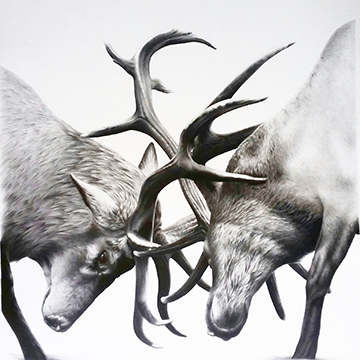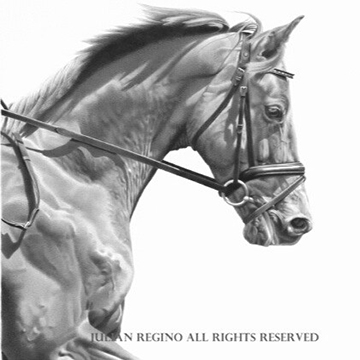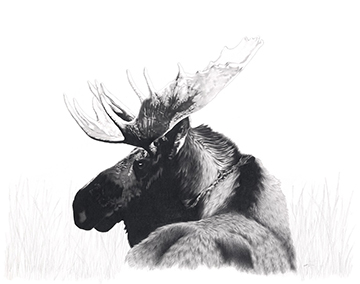Wildlife Portrayed by Julian Regino’s Drawings
Julian Regino, a young Canadian artist, has demonstrated his talents through his meticulously and stunningly capacitive portrait of wildlife. With pencils, he truthfully depicts each animal′s fine details and, more importantly, its inner spirit. Before drawing an animal, Julian spends a fair amount of time studying the animal′s body structure, movement, and character. Gradually, Julian has learned to appreciate wildlife. The animal he draws is not a subject anymore but rather a bonding connecting him with the animal. This is why he can capture the true nature of the animal which is vividly displayed in his drawings. Respectfully, he also carries a lofty ambition for the wildlife beyond drawing. From the following interview, readers can understand how Julian has chosen this path and how he painstakingly draws each animal.

Q: Your drawings are amazing. They are not only realistic portrayals of animals′ outward characteristics but also beautiful captures of their intrinsic spirits. Please tell us when and how you started to develop your drawings using the graphite pencil.
A: I′ve been drawing for as long as I can remember but my first attempt at realism with graphite came when I was 11. I was so intrigued by my art teacher′s (David Kitler) lion painting that inspired me to try drawing in a realistic style. Over years of practice, I have been able to develop my own unique style.
Q: Besides wildlife, have you drawn other objects and what made you decide to focus on wildlife animals?
A: When I started drawing in a realistic style I was more so doing portraits of celebrities referencing out of magazines. I really started to focus on wildlife years later around 2010 when my partner encouraged me to get back into art after taking a few years off due to university and starting a career. I always found wildlife to be a unique and challenging subject matter which helped keep me engaged. Staying engaged is very important as my pieces take a significant time to complete. I have also found that while working on wildlife pieces I always look forward to working on the pieces and have always found something interesting and captivating about the perfection of all wildlife. It was also a subject matter that could appeal to most people. Now, wildlife is a subject I′m passionate about and I wish to give back by donating a portion of my proceeds to a different wildlife foundation.

Q: In your drawings, it seems to me you understand your subjects very well. Do you study a particular animal for a long period of time before you draw it? What are you looking for when you study them?
A: I do study the particular animal for a substantial amount of time before drawing it, usually through photos or videos of the animal. I then first tend to focus on the overall proportions, then I drill down to the anatomy i.e. musculoskeletal form, then I drill down further into the intricacies and features that make that particular species unique.
Q: Please tell us the most important elements in drawing wildlife.
A: The main things I consider in the composition are the animal needs to be uniquely positioned candidly in its natural setting, i.e. I want to avoid the picture-perfect portrait, capture unique details specific to that animal, include a subtle background that compliments the animal.

Q: You mentioned on your website that you want to establish an art portfolio encompassing wildlife from all regions of the world. Please tell us more about this ambition of yours.
A: Ultimately I want to draw various types of wildlife from all parts of the globe to the point where my gallery or exhibits would resemble a wildlife encyclopedia. My dream is to present these animals in a way that people can see the close-up details that they would typically never see in real life. My dream is to travel around the world and study the animals in their natural habitats. As mentioned before, I would love to be able to donate a portion of my earnings towards different wildlife foundations and organizations in order to help preserve such beautiful life forms.
Q: It seems to me you tend to draw a portion of an animal with a thrilling effect. Is there any symbolic meaning in your composition? Please tell us how you compose your drawings.
A: No, I just want to be able to portray the animal in its truest form and showcase the very fine details and nuances people typically don′t get a chance to see. I also tend to have the animal itself in a very detailed form but like to have background elements that are supporting the high detail, without taking away from it, such as blurry trees or grass behind the animal.

Q: What does wildlife mean to you? Do you feel a connection with any particular type of animal, a ″spirit animal″ if you will? If yes, which animal and why?
A: I feel I′m in touch with each animal that I draw however my most significant piece to date would be the grizzly bear. There is something about the strength and beauty of a grizzly bear as well as the intricate details that people normally wouldn′t see that really makes me feel connected to this piece. I really think it is an honor and gift to be able to highlight the unique details of all animals.
Q: When and where is your upcoming exhibition so people can view your drawings in person.
A: Nothing planned at this time as I am currently focusing on creating more pieces.
Through Julian′s candid response, we can see how he has developed his wildlife drawing style. The compassion for wildlife is within him and is expressed through his pencils. We wish him a bright future ahead and hope he can fulfill his ambitions soon.
Julian′s Website
